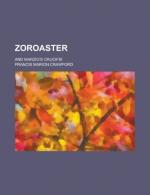That evening Marzio finished the last cherub’s head on the ewer before he left the shop. He had sent Gianbattista home, and had dismissed the men who were working at a huge gilded grating ordered by a Roman prince for a church he was decorating. Marzio worked on by the light of a strong lamp until the features were all finished and he had indicated the pupils of the eyes with the fine-pointed punch. Then he sat some time at his bench with the beautiful piece of workmanship under his fingers, looking hard at it and straining his eyes to find imperfections that did not exist. At last he laid it down tenderly upon the stuffed leather pad and stared at the green shade of the lamp, deep in thought.
The man’s nature was in eternal conflict with itself, and he felt as though he were the battle-ground of forces he could neither understand nor control. A true artist in feeling, in the profound cultivation of his tastes, in the laborious patience with which he executed his designs, there was an element in his character and mind which was in direct contradiction with the essence of what art is. If art can be said to depend upon anything except itself, that something is religion. The arts began in religious surroundings, in treating religious subjects, and the history of the world from the time of the early Egyptians has shown that where genius has lost faith in the supernatural, its efforts to produce great works of lasting beauty in the sensual and material atmosphere of another century have produced comparatively insignificant results. The science of silver-chiselling began, so far as this age is concerned, in the church. The tastes of Francis the First directed the attention of the masters of the art to the making of ornaments for his mistresses, and for a time the men who had made chalices for the Vatican succeeded in making jewelry for Madame de Chateaubriand, Madame d’Etampes, and Diane de Poitiers. But the art itself remained in the church, and the marvels of repousse gold and silver to be seen in the church of Notre Dame des Victoires, the masterpieces of Ossani of Rome, could not have been produced by any goldsmith who made jewelry for a living.
Marzio Pandolfi knew all this better than any one, and he could no more have separated himself from his passion for making chalices and crucifixes than he could have changed the height of his stature or the colour of his eyes. But at the same time he hated the church, the priests, and every one who was to use the beautiful things over which he spent so much time and labour. Had he been indifferent, a careless, good-natured sceptic, he would have been a bad artist. As it was, the very violence of his hatred lent spirit and vigour to his eye and hand. He was willing to work upon the figure, perfecting every detail of expression, until he fancied he could feel and see the silver limbs of the dead Christ suffering upon the cross under the diabolical skill of his long fingers. The monstrous horror of the thought made him work marvels, and the fancied realisation of an idea that would startle even a hardened unbeliever, lent a feverish impulse to this strange man’s genius.




